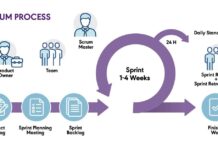Do you want this? What will this cost? Are you willing to pay the price? When are you ready to start paying?
THINK LONG, THINK SHORT
Long Term Objectives
You overestimate what you can do in 1 year and underestimate what you can do in 10 years. Pick something you love because you will give up when you hit the miserable middle. Only love can take you through the long middle. Do not pressure yourself thinking about getting it all done in 1 year. Amazon.com gave itself a much longer runway to become the juggernaut it is today 20 years later.
How long is a long-range goal? Japanese say 250 years. To do that, you need patience. Plant your seeds today so you can reap the crop tomorrow. Plan for a lousy fortune while the fortune is good. If you do not have a destination, you will never get there: set goals, plan to achieve those goals, track your time, and ensure your plan gets executed.
Short Term Objectives
Your first sprint must be on time. Pick a short sprint, small slim end to end feature set, make the plan, and keep it fun. Let clients see your infrastructure, team, and work ethic. Give bite-size nuggets, do not move too fast to overwhelm the client. Do not bear your soul, show common interest, and be polite.
It would be best if you had written down your goals by now. Here is an example template you can use to get started.
| New goal(Passion) | Why you want this? | End Date |
|---|---|---|
| Control LDL Numbers | Prevent heart disease | 11/1/2019 |
Our next step is to take each goal and develop a strategy for each and then execute the plan.
| Vision Category | Goals (specific outcome) | Deadline | Training Knowledge | 3 Helpful Relationships | Next 7steps | Status |
|---|---|---|---|---|---|---|
| Health | Control LDL Numbers from 60 to 30 | 11/1/2019 | find concrete paid and free Classes, Books, Blogs, Podcasts, Youtube | Supportive James Doe1, Jane Doe2, James Doe3 | Working on It | |
| Money | Not Started | |||||
| Personal Growth | Planning |
5 Best Practices for Strategy and Execution
1. PLANNING IS THE MOST IMPORTANT
When setting goals, do it 50% higher than expected because you need to stretch, and you will always fall short. That is proper planning.
Plan every day; it saves you an hour in daily execution. You can do it for an hour daily, or you need to take a day off once per week to do this. The agile methodology involves much more planning because you are planning daily.
WHO WINS? THE ONE WITH BETTER INFO, BETTER PLAN, AND GREATER SKILL – HARVEY MACKAY
HOW MUCH INFORMATION IS THE RIGHT AMOUNT TO GET STARTED?
The right information to make a good enough decision can be done using the following
- get many points of view
- use “force field analysis” framework to close the scope of what important driver and direction to head
- gauge the impact and importance of the missing data on outcome,
- avoid data recency bias,
- make plans that have a backout strategy,
- timebox a date by which you need to arrive at a decision,
- listen to your gut,
- allow disagreement but expect full commitment by all accountable parties after the decision.
How much time you devote to planning should depend on the risk you can assume. The higher the risk, the more you need to plan.
7 questions when assessing risk:
- How long to failover?
- Is there a backout plan?
- Have similar changes been done before, and was it successful?
- Does the client approve of the changes?
- How critical is it that changes are made?
- What is changing? (technology, process, or management)
- What is the worst case if this goes south? # of clients/configurable items impacted, are the clients external or internal or both?
2. LET STRATEGIC PLANS DEGENERATE INTO ACTIONS
Plans are useless, but planning is indispensible – Dwight Eisenhower
Find activities per milestone goal; this will constitute your project plan. Collaborate with the team to have a shared unified action-oriented understanding.
Iterate as many times as you can end to end to foster a learning and conditioning process. Learning takes time: planning, acting, and reviewing make learning. Plan, then act, then reshape your plan, then act again.
3. WHAT YOU INSPECT DETERMINES WHAT YOU CAN EXPECT
Inspection is clear communication on a relevant plan, accountability, measuring, and moving forward inch by inch. It is important to see the cross impacts and communicate as you make changes.
Each iteration can do each task faster and better than before when there is a review of the following: purpose, objectives, milestones, action, plan, and collaboration.
4. RESPOND TO CHANGE
Be prepared for change and adapt to it. Do not avoid change so you can stick to the plan. Prove the math and have a backup plan. The biggest complaint about professionals is they are too slow. Practice to prevent this and have a plan when things go wrong.
5. MEASURE PROGRESS
Measuring and monitoring results daily, a detailed marketing plan with specific growth expectations, and setting appropriate goals. Put growth thinking in every area of the business. There is not ONE objective but many objectives. In business, we measure 8 key areas:
- Marketing,
- Innovation,
- Physical resources,
- Financial resources,
- HR,
- Productivity,
- Profitability,
- Social.
Project Management Terminology
Natural Planning Method: Why? Then drive that project over core values. Next is a clear vision of the outcome, tasting what success tastes like (what?), Brainstorming the many options, then components or milestones, sequence, and priority to get done
Unnatural planning usually starts with crises until a consultant comes in and asks, why are we doing this, and then it starts at the top with natural planning methods.
The process: If this were farming, it would be to pep the soil, choose the right seeds, plant, and be faithful in watering, weeding, and cultivation, let god and nature do the rest. So too, we must plan, invest with excellence, show consistency, pay attention, and have empathy and appreciation.
A Strategic Action plan is how to get from a C+ to a B+; this is the action after the post-implementation review is complete; it is the steps to improvement.
5 steps of the achievement action plan:
- What precisely to accomplish and what is the deadline?
- What does it mean to me?
- 3-5 major components of accomplishment?
- Exact steps and deadlines for each of the steps for each component?
- Weekly time investment? Achieve?
The Critical Path Chart lays out the strategic map, determines the dependencies, and estimates the segment’s force. It is precise planning incredibly early in a project.
Pareto tasks: not all tasks have the same impact on the outcome. Ideally, you want to do the least tasks you need to accomplish to achieve the objective. The objective setting is to put that check on your mirror and ensure you can cash it. Are you doing the things you need to do to cash it?
7×7 program for making Plan for a Goal. Dreams are just dreams; goals are dreams with a plan and a deadline. Write them down to give them the substance you need to force them to carry them out. Pick the first 7 things to get it done, then 7 actions on those 7 things.
make lists, allocate time per task, never book more than 6 tasks or 6 hours, create a daily plan, buffer against ad-hoc tasks, reactive vs. proactive, i.e., planned vs. unplanned tasks, buffer against unplanned
Priority setting: Take stock of the inventory of work so you do not get overbooked, then schedule stuff for later, do not let ad-hoc work pop up and take over planned work
never wing a telephone call, summarize a plan for any call. listen a lot but ensure that, leaving meetings, everyone has explicit action plans
you must plan on how to engage the community
Theory of Constraints runs a system called Drum, Buffer, Rope (DBR). The drum is the system’s constraint; the Buffer plans for the main constraint set, and Rope communicates how to open the gate for the constraint.
Project Management Frameworks
- SEI – Capability Maturity Model (CMM)
- ISO 9000
- DMAIIC – Six Sigma
- PMI -Work Breakdown Structure (WBS)
- Lean
- The Theory of Constraints
- Agile
Stephen Choo Quan
Thanks for reading and Sharing













